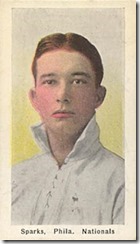by Scott Fennessy
Philadelphia PA
7/26/1905
 The Cubs face the Phillies in game 3 of this series. Mordecai Brown coming off another great start faces Tully Sparks (right) of the Phillies who has pitched very well with a 12-12 record and a 2.07 ERA and a no hitter coming into this. The Bruins continue their recent roll while the Phillies are struggling just to stay afloat at this point.
The Cubs face the Phillies in game 3 of this series. Mordecai Brown coming off another great start faces Tully Sparks (right) of the Phillies who has pitched very well with a 12-12 record and a 2.07 ERA and a no hitter coming into this. The Bruins continue their recent roll while the Phillies are struggling just to stay afloat at this point.
Both pitchers look good with no score in the first, and the middle of the Cubs shuffled lineup has been responding of late, taking some pressure off the bottom of the order where things have been kind of weak lately.
Frank Chance himself starts the rally with a booming double to left to start the inning. Except for Johnny Evers nobody on the team has been hitting better in the last week, except for possibly Jim Casey who takes Sparks 3rd pitch of the at bat down the first base line and it’s fair! This goes all the way to the corner and Hugh Duffy has to chase it down. Chance scores easily and Casey slides just under Ernie Courtney’s tag and has a triple, and the Cubs take a 1 run lead. Johnny Kling has a long at bat and after fouling off a couple hits one to straightaway center and Sherm Magee makes the catch, but he does not try for the runner and the run scores. The inning comes to an end with the Cubs on top 2-0. The Phillies go down quietly to end the inning.
The score was still 2-0 Cubs in the bottom of the 4th when the Phillies crack the scoreboard. Bill Gleason who had been struggling badly rips one into the left center gap. Jimmy Slagle corrals the ball and fires it in to Evers at short and the throw to third was not even close. Still on third with 1 out Duffy hits one to right field where Frank Schulte waits and makes a strong throw home, but the speedy Gleason scores just ahead of the throw. Brown then gets the final out and the score is now 2-1 Cubs.
The score had not changed when the Cubs got a gift from Magee who drops Brown’s fly ball to start the frame. Evers grounder moves the slow footed pitcher to second and with two out Schulte gets a single that scores the Bruin hurler and increase the lead to 3-1 which is how the inning ended.
That was the end of the scoring as both pitchers looked sharp the rest of the way and the Cubs grind this one out 3-1. Brown has looked very impressive over his last three starts and the Cubs are still hanging in the race. For the Phillies, the bats left Sparks hanging again as he pitched a beauty only to come up on the short end of the stick again.
Giants 57 18 .760
Cubs 54 23 .701
Pirates 47 29 .618




Go Cubs!
Hey Scott, a question… in my 1966 replay, I know I have to adjust my managerial style to fit the era. Things such as not having so many rigid,specialized roles as current day baseball. I imagine it’s ten times as different for you replaying the 1905 season. What general rules or guidelines do you follow?
thanks!
Hi Tom,
Not 100% sure what you mean by “rules or guidelines” but I find myself using the hit and run a lot, probably 7-10 times a game, and I sacrifice bunt a lot too. Sometimes 2-4 times per game.
I hate giving up outs, but there are a lot of teams whose 7-9 are automatic outs anyway and with pitching being so dominant, and defense a non factor you need to get runners in scoring position any way possible.
The drawback with hit and run in my replay since there are so many A pitchers that many hits are turned into outs because of the H&R chart book, and then there are a lot of second column 2’s which turn triples into outs also. Don’t get me started on 33/34 results. But because many players have the three 31’s it’s too tempting to not try to take advantage. That and I am a big stolen base guy.
I am pretty sad to see today’s game with supposedly faster players plod along one base at a time and 35 steals is good enough to lead the league now. Sad when the 80’s is now “way back” and guys like Henderson and Raines would have more steals by the all star break than today’s players would have all season.
Managing pitching staffs is certainly a challenge, as most teams don’t have bullpens. There is the odd team like the White Sox, A’s, Cubs and Giants that have very deep staffs, but most only have the three good starters, so you don’t lift your starter as you end up going from an A or B to a D and watch any hope for coming back vanish.
The White Sox are also unique in that they did not carry a lot of players in general in the early days. Not sure if $ were tight or just only played their starters. Only 2 reserve players in 1901 and 3 in 1902 as examples.
I do use relief pitchers in mop up roles, but have to be judicious as to “can they actually come back?”
I also have to fight the injury bug a LOT. Especially with third baseman and the strange trend of 23 with runner on second.